Buenos Aires – Cinnamon is the bark of a tropical evergreen tree – related to the laurel, or bay tree. There are two main types – Ceylon, more properly these days I suppose it ought to be called Sri Lankan (Cortex Cinnamoni), but then we haven’t changed the name of the tea either; and Chinese, also called cassia, false cinnamon, and bastard cinnamon (Cinnamomum aromaticum). The latter is grown in China and Burma, and is used both as a flavoring agent, and as a medicinal spice for conditions as wide ranging as appetite loss, bronchitis, colds, cough, fever, indigestion, sore throat, resistance to infection, impotence, diarrhea, bed-wetting, rheumatism, testicle hernia, failure to menstruate, and symptoms of menopause. There is Indonesian cinnamon (Cassia vera), worldwide a less important spice, and with a stronger flavor, used mainly for cinnamon oil and extract. And, there is Vietnam, or Saigon, cinnamon (Cinnamomum loureirii), but the production of essential oils of this variety tend towards poor quality, most of it is used locally in the making of herbal broths.
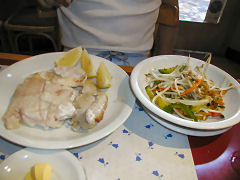 The only reason that cinnamon is of any particular interest this morning is that the Spanish name is that of a small cafe, Canela, Juncal 2124, a spot that we have lunch at close to once a week. It’s a small, homey feeling coffee shop, seating 22 people, and run by a cook, the owner, and a waitress. It’s open in the mornings for coffee and pastries, then offers lunch, then goes back to coffee and pastries, finally closing up about 7 or 8 in the evening. The coffee is good, as is the selection of teas. The pastries are limited, but usually quite good, especially their orange-flavored ricotta tart. They make fresh scones which are absolutely delicious. And, their lunches are quite good – we’ve never been disappointed with anything we’ve had. Pastas, salads, and simply prepared meats (mostly lighter – chicken and fish), are the core of the menu.
The only reason that cinnamon is of any particular interest this morning is that the Spanish name is that of a small cafe, Canela, Juncal 2124, a spot that we have lunch at close to once a week. It’s a small, homey feeling coffee shop, seating 22 people, and run by a cook, the owner, and a waitress. It’s open in the mornings for coffee and pastries, then offers lunch, then goes back to coffee and pastries, finally closing up about 7 or 8 in the evening. The coffee is good, as is the selection of teas. The pastries are limited, but usually quite good, especially their orange-flavored ricotta tart. They make fresh scones which are absolutely delicious. And, their lunches are quite good – we’ve never been disappointed with anything we’ve had. Pastas, salads, and simply prepared meats (mostly lighter – chicken and fish), are the core of the menu. 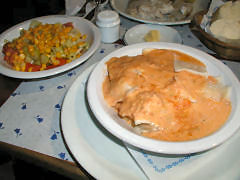 One of our favorites is the merluza, pan “steamed” in herbs and served with your choice of side dishes (I recommend the side-sized portion of one of their vegetarian main dishes, the nituke de vegetales, a really good mixed vegetable saute) – the fish is easily an 8-10 ounce portion, more than enough for lunch. We’ve also really enjoyed their chicken and mushroom risotto, the rice cooked to just the right consistency. And yesterday, I tried their salmón rosado and ricotta raviolines in a mixed tomato and white sauce. Excellent!
One of our favorites is the merluza, pan “steamed” in herbs and served with your choice of side dishes (I recommend the side-sized portion of one of their vegetarian main dishes, the nituke de vegetales, a really good mixed vegetable saute) – the fish is easily an 8-10 ounce portion, more than enough for lunch. We’ve also really enjoyed their chicken and mushroom risotto, the rice cooked to just the right consistency. And yesterday, I tried their salmón rosado and ricotta raviolines in a mixed tomato and white sauce. Excellent!
[Note: this restaurant has closed.]
Let us just start with a simple “compare and contrast”:
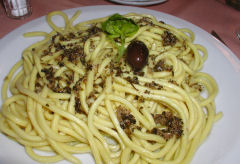
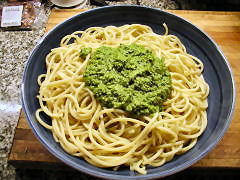
I’m hoping I don’t need to walk anyone through this one. The first picture is that of what seems to be a typical pesto here – this particular one served at a terribly uninteresting food-wise restaurant in La Boca – described as fettucini al pesto – a pasta clearly not fettucini, but actually, as in the next picture, foratini, swimming in cooking grade olive oil, and topped with a sprinkling of dried basil flakes (and one fresh leaf atop for color), chopped, cooked garlic, and a black olive. The latter, a lovely, steaming bowl of foratini, a thin, tubular pasta also known as bucatini, lightly coated in good olive oil, and topped with a mouthwatering verdant puree. I leave you to imagine the difference in the gustatory experience.
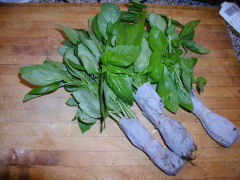 Pesto consists of roughly seven ingredients. You can vary them quite a bit, starting from a traditional Genoese pesto based on basil and pinenuts, on to all sorts of wild variations – we’ve seen them in restaurants all over the place – arugula walnut pesto, watercress almond pesto – it’s limited only by one’s imagination. At its base, however, is the quality and freshness of the ingredients – because this is an uncooked sauce, and with limited ingredients that are simply pureed together, the freshness and flavor have to shine through. That base of seven ingredients is garlic, herbs, nuts, olive oil, cheese, salt, and pepper. Nothing more, nothing less. The proportions are really to taste – one of my problems often in presenting recipes is I tend to cook by starting with a rough amount of each item and then adjusting as I go – afterwards I have to figure out what I did.
Pesto consists of roughly seven ingredients. You can vary them quite a bit, starting from a traditional Genoese pesto based on basil and pinenuts, on to all sorts of wild variations – we’ve seen them in restaurants all over the place – arugula walnut pesto, watercress almond pesto – it’s limited only by one’s imagination. At its base, however, is the quality and freshness of the ingredients – because this is an uncooked sauce, and with limited ingredients that are simply pureed together, the freshness and flavor have to shine through. That base of seven ingredients is garlic, herbs, nuts, olive oil, cheese, salt, and pepper. Nothing more, nothing less. The proportions are really to taste – one of my problems often in presenting recipes is I tend to cook by starting with a rough amount of each item and then adjusting as I go – afterwards I have to figure out what I did. 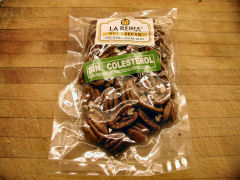 Last night’s pesto popped up purely because when I was in the store earlier, there was this lovely display of young, fresh basil. Pesto immediately popped into mind as a probability, and I grabbed three bunches. Unfortunately, pinenuts are hard to find here, and outrageously expensive. Walnuts are easy, but expensive. Surprisingly, and the first time I’ve seen them here, the store had bags of pecans – grown in the province of Entre Rios, near the city of San Juan, right here in Argentina! Who knew? And the price wasn’t too bad – 5 pesos and change for 100 grams (roughly 4 ounces), certainly by comparison to their neighboring walnuts at 11 pesos for the same quantity.
Last night’s pesto popped up purely because when I was in the store earlier, there was this lovely display of young, fresh basil. Pesto immediately popped into mind as a probability, and I grabbed three bunches. Unfortunately, pinenuts are hard to find here, and outrageously expensive. Walnuts are easy, but expensive. Surprisingly, and the first time I’ve seen them here, the store had bags of pecans – grown in the province of Entre Rios, near the city of San Juan, right here in Argentina! Who knew? And the price wasn’t too bad – 5 pesos and change for 100 grams (roughly 4 ounces), certainly by comparison to their neighboring walnuts at 11 pesos for the same quantity.
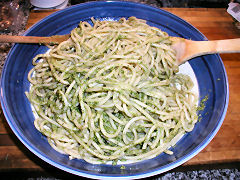 I make the pesto while the pasta is cooking – it really is that fast. I put the pot of water on to boil. While it was heating, I dropped two large cloves of garlic into the blender, along with the leaves of the basil (you can toss the stems or use them to make a little basil herb broth for some other use), about half the bag of pecans, so 2 ounces, and a couple ounces of the only cheese we had in house, some port salut. I added about half a teaspoon of salt and a quarter teaspoon of freshly ground white pepper, and then just a splash of olive oil to get things started. Start up the blender – initially it won’t puree, it’ll just start sort of chopping – and start drizzling olive oil in through the top (most blenders have some sort of way to do that) – and I do mean drizzle, because you want just enough olive oil to get the ingredients to puree into a thick, sauce-like consistency – it probably ended up being about half a cup, maybe a little less. If you add too much it just slides off the pasta. Scrape down the sides, stir it up a little, add a little more salt if needed, and you’re done. When the pasta is cooked, al dente of course, toss it with a little olive oil, and then top with the pesto.
I make the pesto while the pasta is cooking – it really is that fast. I put the pot of water on to boil. While it was heating, I dropped two large cloves of garlic into the blender, along with the leaves of the basil (you can toss the stems or use them to make a little basil herb broth for some other use), about half the bag of pecans, so 2 ounces, and a couple ounces of the only cheese we had in house, some port salut. I added about half a teaspoon of salt and a quarter teaspoon of freshly ground white pepper, and then just a splash of olive oil to get things started. Start up the blender – initially it won’t puree, it’ll just start sort of chopping – and start drizzling olive oil in through the top (most blenders have some sort of way to do that) – and I do mean drizzle, because you want just enough olive oil to get the ingredients to puree into a thick, sauce-like consistency – it probably ended up being about half a cup, maybe a little less. If you add too much it just slides off the pasta. Scrape down the sides, stir it up a little, add a little more salt if needed, and you’re done. When the pasta is cooked, al dente of course, toss it with a little olive oil, and then top with the pesto.
I’ve added a second version of the restaurant review index over in the righthand column – divided up by cuisine – I’ve heard from a few folk that although the alphabetical main list was searchable by using a simple Find in their browsers, that it would be really nice to have similar types of restaurants grouped together. I’ve only done the cuisine index for the Buenos Aires area restaurants, since I think the other cities, at least for now, have a limited enough listing to not warrant it.
[…] We weren’t holding out a lot of hope by this point for the pastas we’d ordered. We had been impressed with the menu selection – easily a dozen different pastas, with a choice of two dozen sauces, many of which sounded quite creative. Add to that another dozen house special pastas with their own predetermined sauces and it’s clear these folks are serious about the genre. Thankfully, they deliver on this part of the menu. Henry loves my pesto, and I know what usually passes for the stuff here, so I tried to talk him out of ordering it here, despite their assurances on the menu that they use fresh basil, walnuts, garlic, and parmesan. As it turned out, it wasn’t bad. It still isn’t on the scale of truly intense fresh pesto, but, it wasn’t bad. Next time, puree the garlic and nuts in with the basil and cheese and you’ll be closer… […]
[…] So, fresh semolina pasta – a simple mix of 2 cups of all purpose flour, 2 cups of semolina flour, a large pinch of salt, 6 eggs, and 2 tablespoons of olive oil. Knead it until it’s a smooth dough, then let it rest at room temperature for a minimum of half an hour. Then roll it out and cut into the shape you want (or use a machine as I did). I’ve covered making fresh pesto before, so I’m not going to repeat myself. This one was made with basil, walnuts, garlic, and parmesan. I used white pepper instead of black because I’d used so much black pepper in the previous dish. […]